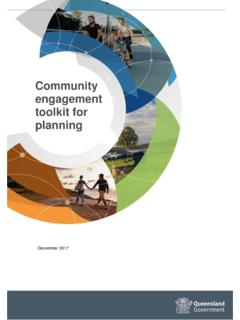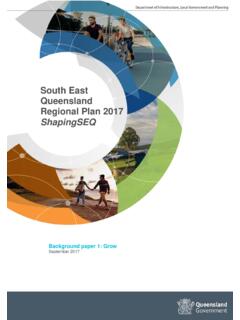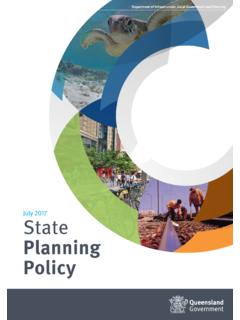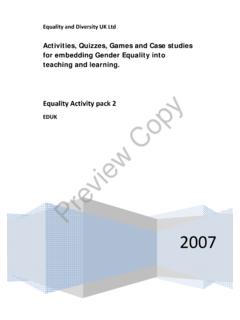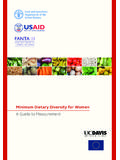Transcription of State Planning Policy state interest guidance material
1 State Planning Policy State interest guidance material Liveable communities July 2017 State interest guidance material Liveable communities The State of Queensland, July 2017. Published by the Department of Infrastructure, Local Government and Planning , 1 William Street, Brisbane Qld 4000, Australia. Licence: This work is licensed under the Creative Commons CC BY Australia licence. To view a copy of the licence, visit Enquiries about this licence or any copyright issues can be directed to the department by email to or in writing to PO Box 15009, City East Qld 4002. Attribution: The State of Queensland, Department of Infrastructure, Local Government and Planning . The Queensland Government supports and encourages the dissemination and exchange of information. However, copyright protects this publication. The State of Queensland has no objection to this material being reproduced, made available online or electronically but only if it is recognised as the owner of the copyright and this material remains unaltered.
2 The Queensland Government is committed to providing accessible services to Queenslanders of all cultural and linguistic backgrounds. If you have difficulty understanding this publication and need a translator, please call the Translating and Interpreting Service (TIS National) on 131 450 and ask them to telephone the Queensland Department of Infrastructure, Local Government and Planning on 13 QGOV (13 74 68). Disclaimer: While every care has been taken in preparing this publication, the State of Queensland accepts no responsibility for decisions or actions taken as a result of any data, information, statement or advice, expressed or implied, contained within. To the best of our knowledge, the content was correct at the time of publishing. Any references to legislation are not an interpretation of the law. They are to be used as a guide only. The information in this publication is general and does not take into account individual circumstances or situations. Where appropriate, independent legal advice should be sought.
3 An electronic copy of this report is available on the Department of Infrastructure, Local Government and Planning s website at State interest guidance material Liveable communities Contents Using the SPP State interest guidance material .. 1 Part 1: Understanding the State interest .. 3 Part 2: Integrating the State interest policies .. 5 Part 3: Mapping .. 13 Part 4: Applying assessment benchmarks .. 14 Part 5: Example Planning scheme provisions .. 16 Part 6: Supporting information .. 21 1 State interest guidance material Liveable communities Using the SPP State interest guidance material The Queensland Government established the State Planning Policy (SPP) to define the matters of State interest in land-use Planning and development. State interests in the SPP consist of a State interest statement, State interest policies and, where applicable, assessment benchmarks. This guidance material has been prepared to support the implementation of the SPP and the interpretation of the Liveable communities State interest .
4 Although the SPP broadly applies to a range of activities undertaken by State and local governments, the guidance material is particularly focused on assisting local governments when making or amending a local Planning instrument and when applying the assessment benchmarks (to the extent relevant). The SPP does not prioritise one State interest over another, providing flexibility for decision makers to respond to specific regional and local circumstances. This allows for the State interests to be considered in their entirety rather than as individual or separate priorities. State interests are to be considered in the context of the guiding principles in the SPP, which promote an outcome focused, integrated, efficient, positive and accountable Planning system. The SPP guidance material is intended to be read in conjunction with the SPP and the relevant State interest . The SPP guidance material is not statutory in its effect and does not contain any new Policy . It is not mandatory for local governments to use the guidance material but it is provided to assist with the interpretation and application of the State interest policies and the assessment benchmarks contained in the SPP.
5 2 State interest guidance material Liveable communities The SPP guidance material is structured as follows: Part 1: Understanding the State interest This section briefly explains why a particular matter is a matter of State interest , describes the purpose of the relevant State interest statement and defines the core concepts associated with the State interest . Part 2: Integrating the State interest policies This section provides background and further explanation for each of the State interest policies defined in the SPP. It also provides examples and options regarding how to appropriately integrate each State interest Policy into a local Planning instrument. Part 3: Mapping This section identifies and explains the mapping layers contained in the SPP Interactive Mapping System (IMS) relevant to a particular State interest . It also clarifies how a local government can locally refine State mapping in certain instances and outlines where online mapping for the State interest can be accessed (if relevant).
6 Part 4: Applying assessment benchmarks In accordance with the Planning Regulation, an assessment manager or referral agency must have regard to the SPP when assessing a development application. For some State interests, there are also specific assessment benchmarks that must be used by a local government for development assessment. This section outlines the development applications to which the assessment benchmarks apply and how a development application may demonstrate compliance with these benchmarks, to the extent that these are relevant. The assessment benchmarks contained in this section will apply to assessable development in addition to any assessment benchmarks contained in a local Planning instrument, to the extent of any inconsistency. Part 5: Example Planning scheme provisions This section provides example Planning scheme provisions that a local government may choose to adopt, or to adapt, when making or amending a local Planning instrument. It is important to note that the example Planning scheme provisions provided may only be in relation to a particular aspect of a State interest , rather than addressing all of the particular State interest Policy requirements.
7 Part 6: Supporting information This section provides a list of technical resources that a local government may wish to consider when making or amending a Planning scheme. This section also provides a glossary of terms and acronyms used throughout the SPP guidance material . Where text in this guidance material is in a coloured text box, it is an excerpt from the SPP and is either the State interest statement, State interest Policy or the assessment benchmarks applicable to the Liveable communities State interest . Any queries related to the SPP guidance material or the SPP should be sent to 3 State interest guidance material Liveable communities Part 2 Integrating the State interest policies Part 1: Understanding the State interest Background The liveability of communities is of particular interest to the Queensland Government because it directly influences quality of life and wellbeing. A range of factors are in play, including the characteristics of the built and natural environments; access to employment, goods and services, and open space; and our resilience to natural hazards and the effects of climate change.
8 As the population of our cities, towns and regions change, and the socio-economic and demographic profiles reflect that change, the importance of attractive, healthy, safe, accessible and inclusive places and spaces increases. Core concepts Liveable communities Liveable communities are those that are vibrant, prosperous, sustainable, diverse, inclusive, accessible, attractive, healthy and safe for all community members. Creating well-functioning, successful communities requires a long-term commitment to a combination of land-use Planning , infrastructure investment, design and community development strategies. Planning and designing for liveable communities offers benefits to residents, businesses, workers and visitors to these communities, while advancing the health and prosperity of the State . Planning for a liveable community, including making allowances for future growth, will help to ensure the long-term success of the community. Liveable communities are most successful when they are inclusive and all community members feel a strong sense of place and belonging.
9 The success of communities is advanced where communities are well connected to surrounding neighbourhoods, regions and towns. Liveable communities are those that also cater for the diverse needs of all people and abilities in the community, including people with disabilities or restricted mobility, seniors, and people with young children. High-quality urban design and place-making The quality of our suburbs, towns and cities has a significant impact on everyday life. People are strongly influenced by the physical and natural environment with the form, shape and pattern of land use providing the platform for human interaction and behaviour. The scale, intensity, legibility and aesthetics of places and spaces can have a positive influence on how well people interact with, access, and connect to, the place. Well-planned neighbourhoods can support safe, socially cohesive and inclusive communities and healthy lifestyles. To enhance liveability, built and natural environments can be innovatively designed, or transformed, through the well-planned placement and design of buildings, pedestrian and cyclist access, road and street networks, sport and recreation facilities, and public open spaces.
10 Features such as shade, shelter, seating and footpaths can encourage walking and contribute to the accessibility of public transport, public places and local recreational State interest statement Liveable, well-designed and serviced communities are delivered to support wellbeing and enhance quality of life. 4 State interest guidance material Liveable communities Part 2 Integrating the State interest policies facilities for all people of all ages and abilities. It is important that quality open space offers a series of diverse spaces that accommodate a range of different uses, users and needs, and allows for different activities at different times of the day and seasons. Buildings, streets and spaces that are designed to work with and respond to the local climate create places and spaces that are resource efficient and deliver climate-resilient, cost-effective and comfortable living. Development that adopts a passive design approach, using natural elements such as sunlight and breezes to heat, cool and light buildings, reduces or eliminates the need for mechanical and electrical systems such as air conditioning.
